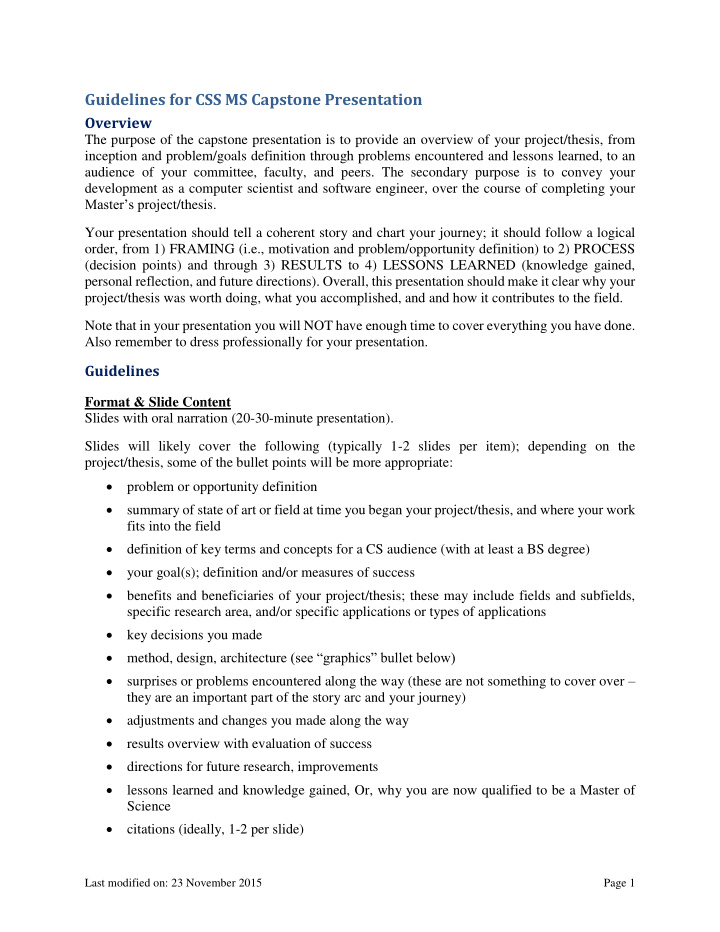



Guidelines for CSS MS Capstone Presentation Overview The purpose of the capstone presentation is to provide an overview of your project/thesis, from inception and problem/goals definition through problems encountered and lessons learned, to an audience of your committee, faculty, and peers. The secondary purpose is to convey your development as a computer scientist and software engineer, over the course of completing your Master’s project /thesis. Your presentation should tell a coherent story and chart your journey; it should follow a logical order, from 1) FRAMING (i.e., motivation and problem/opportunity definition) to 2) PROCESS (decision points) and through 3) RESULTS to 4) LESSONS LEARNED (knowledge gained, personal reflection, and future directions). Overall, this presentation should make it clear why your project/thesis was worth doing, what you accomplished, and and how it contributes to the field. Note that in your presentation you will NOT have enough time to cover everything you have done. Also remember to dress professionally for your presentation. Guidelines Format & Slide Content Slides with oral narration (20-30-minute presentation). Slides will likely cover the following (typically 1-2 slides per item); depending on the project/thesis, some of the bullet points will be more appropriate: problem or opportunity definition summary of state of art or field at time you began your project/thesis, and where your work fits into the field definition of key terms and concepts for a CS audience (with at least a BS degree) your goal(s); definition and/or measures of success benefits and beneficiaries of your project/thesis; these may include fields and subfields, specific research area, and/or specific applications or types of applications key decisions you made method, design, architecture (see “graphics” bullet below) surprises or problems encountered along the way (these are not something to cover over – they are an important part of the story arc and your journey) adjustments and changes you made along the way results overview with evaluation of success directions for future research, improvements lessons learned and knowledge gained, Or, why you are now qualified to be a Master of Science citations (ideally, 1-2 per slide) Last modified on: 23 November 2015 Page 1
graphics (pertinent diagrams, charts, illustrations, photographs, etc.) on most slides Visual Design Your slides will: have a unified design, incorporating Williams’ four principles (Proximity, Alignment, Repetition, and Contrast) use fonts to signal the hierarchy of ideas (big concepts versus details) be clean and uncluttered (neither dominating nor distracting from your content) be easily read and comprehended by your audience (use a minimum 24-point font) include readable graphics (diagrams, etc.) limit the number of ideas per slide (maximum ~4-5) Delivery Your delivery will: convey your ease and familiarity with all aspects of your project/thesis, its relation to the field/subfield, and all relevant concepts be practiced (multiples times and out loud) be well-paced, not rushed fit the time parameters given (time your practices!) focus on the most important aspects of your project/thesis engage, rather than distract, the audience: resist the temptation to stare at the screen or your notes through the entire presentation (and don ’t read your slides, word -for-word) make brief eye contact with a few friendly-looking people in the audience resist the temptation to rock or otherwise move your lower body in ways that will be distracting project your voice so it can be heard Preparation Give a practice presentation one month before your defense. While doing a presentation so early may seem unnecessary, former students have remarked on the value of doing it. This will: o give you plenty of time to modify it as necessary o help you realize where you need to create additional content or do additional analysis Use an iterative process to decide what to cover in your presentation: o Create a presentation that covers the ONE MOST IMPORTANT aspect of your project/thesis o If you have more time, add ONE more aspect Last modified on: 23 November 2015 Page 2
o Repeat the prior step until your presentation is full (e.g., takes 30 minutes) Include your Message in One Sentence (MIOS) for your project/thesis. This is a single, normal length sentence that captures the essence of what you accomplished in your project/thesis. Resources Anderson, Chris. “How to Give a Killer Presentation: Lessons from TED.” Harvard Business Review (June 2013) Reynolds, Garr. Presentation Zen: Simple Ideas on Presentation Design and Delivery (2 nd edition) Williams, Robin. The Non- Designer’s Design Book (any edition) Peach Pit Press. Last modified on: 23 November 2015 Page 3
Recommend
More recommend